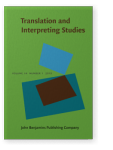A corpus-driven analysis of uncertainty and uncertainty management in Chinese premier press conference
interpreting
This paper examines uncertainty encountered by expert interpreters at Chinese Premier Press Conferences by marking
interpreters’ five types of hesitation phenomena and analyzes uncertainty management strategies. Results show (1)
self-corrections, repetitions, and reformulations occur less frequently than pauses, indicating expert interpreter’s better
control of interpreting fluency; (2) speakers may impact interpreters’ hesitation with segment length positively correlated with
interpreters’ pauses, self-correction, and reformulation, and speaking rate explains the variance in the occurrence of filled
pauses; (3) pauses occur for retrieving lexical and morphological information, eliminating logical doubt, and explicating cultural
connotation; (4) expert interpreters adopt addition and rank shift more than ellipsis, simplification, splitting, and repetition
as uncertainty management strategies, showing an emphasis on adequacy, comprehensibility, and acceptability in their output.
Article outline
- Introduction
- Methodology
- Results
- Occurrence of hesitation phenomena
- Potential relationships between pauses and interpreters’ uncertainties
- Pauses for lexical retrieval
- Pauses for morphological retrieval
- Pauses for logical doubt
- Pauses for cultural connotation explicitation
- Pauses for information processing overload
- Strategies adopted for uncertainty management
- Rank shift (lexical)
- Rank shift (Syntactic)
- Addition (Morphemic addition)
- Addition (Semantic explanation)
- Discussion
- Findings from quantitative study
- Qualitative interpretation of the findings
- Conclusion
- Acknowledgements
-
References
References
Amirian, Zahra and Mohamad J. Baghiat
2013 “
Uncertainty and uncertainty management: The metacognitive state of problem-solving of professional (experienced) translators and students of translation studies.”
International Journal of English Language & Translation Studies 1(2): 223–42.

Angelone, Erik, and Gregory M. Shreve
2011 “
Uncertainty management, metacognitive bundling in problem solving and translation quality.” In
Cognitive Exploration of Translation, ed.
Sharon O’Brien, 108–29. New York: Continuum.

Bachy, Sylviane, et al.
2007 Conventions de Transcription Régissant les Corpus de la Banque de Données VALIBEL. [Transcription Conventions of the Corpora Included in the VALIBEL Database].
[URL]
Cenoz, Jasone
1998 “
Pauses and communication strategies in second language speech.”
College Student 111: 1–11.

Gile, Daniel
2002 “
Conference interpreting as a cognitive management problem.” In
The Interpreting Studies Reader, ed. by
Franz Pöchhacker and
Miriam Shlesinger, 163–76. New York: Routledge.

Gile, Daniel
2015 “
Effort models.” In
Routledge Encyclopedia of Interpreting Studies, ed. by
Franz Pöchhacker, 135–37. New York: Routledge.

Goldman-Eisler, Frieda
1968 Psycholinguistics: Experiments in Spontaneous Speech. London: Academic Press.

Granholm, Eric, Robert F. Asarnow, Andrew J. Sarkin, and Karen L. Dykes
1996 “
Pupillary responses index cognitive resource limitations.”
Psychophysiology 33(4): 457–61.


He, Gujia
2002 “
Fanyizhong de lianciqianxi” [Analysis of conjunction in translation].
Journal of Nanhua University 121: 93–95.

Jakobsen, Arnt L.
2002 “
Translation drafting by professional translators and by translation studies.” In
Empirical Translation Studies: Process and Product, ed. by
Gyde Hansen, 191–204. Copenhagen: Samfundslitteratur.

Kenny, K. Dallas
1996 Language Loss and the Crisis of Cognition: Between Socio- and Psycholinguistics. New York: Mouton de Gruyter.


Kohn, Kurt, and Sylvia Kalina
1996 “
The strategic dimension of interpreting.”
Meta 41(1): 118–38.


Liu, Minhua
2008 “
How do experts interpret? Implications from research in interpreting studies and cognitive science.” In
Efforts and Models in Interpreting and Translation Research, eds.
Gyde Hansen,
Andrew Chesterman, and
Heidrun Gerzymisch-Arbogast, 159–78. Amsterdam: John Benjamins.

Maclay, Howard, and Charles E. Osgood
1959 “
Hesitation phenomena in spontaneous English speech.”
Word 151: 19–44.


Mead, Peter
2005 “
Methodological issues in the study of interpreters’ fluency.”
The Interpreters’ Newsletter 131: 39–63.

Peavler, Scott W.
1974 “
Pupil size, information overload, and performance differences.”
Psychophysiology 11(5): 559–66.


Pio, Sonia
2003 “
The relation between ST delivery rate and quality in simultaneous interpretation.”
The Interpreters Newsletter 121: 69–100.

Plevoets, Koen, and Bart Defrancq
Plevoets, Koen, and Bart Defrancq
Pöchhacker, Franz
2004 Introducing Interpreting Studies. London: Routledge.


Poock, Gary K.
1973 “
Information processing vs. pupil diameter.”
Perceptual and Motor Skills 37(3): 1000–1002.


Shreve, Gregory M.
2006 “
The deliberate practice: Translation and expertise.”
Journal of Translation Studies 9(1): 27–42.

Tiselius, Elisabet, and Gard B. Jenset
2011 “
Process and product in simultaneous interpreting.” In
Methods and Strategies of Process Research Integrative Approaches in Translation Studies, ed. by
Cecilia Alvstad,
Adelina Hild, and
Elisabet Tiselius, 269–300. Amsterdam: John Benjamins.


Yang, Chengshu, and Junmin Deng
2011 “
Laoshouyuxinshouyiyuan de kouyijueceguocheng” [Decision-making between professional interpreters and novice interpreters in simultaneous interpretation].
Chinese Translators Journal 32(4): 54–59.

Zhang, Wei
2015 “
Zhongguokouyixuexizheyuliaoku de kouyiceluebiaozhu: fangfayuyiyi” [Tagging of interpreting strategies in CILC: Method and Significance].
Journal of Foreign Languages 38(5): 63–73.

Cited by
Cited by 3 other publications
Abdel Latif, Muhammad M. M.
2020.
Translation/Interpreting Process Research. In
Translator and Interpreter Education Research [
New Frontiers in Translation Studies, ],
► pp. 85 ff.

Ouyang, Lingwei, Qianxi Lv & Junying Liang
2021.
Coh-Metrix Model-Based Automatic Assessment of Interpreting Quality. In
Testing and Assessment of Interpreting [
New Frontiers in Translation Studies, ],
► pp. 179 ff.

Shen, Mingxia & Junying Liang
2021.
Self-repair in consecutive interpreting: similarities and differences between professional interpreters and student interpreters.
Perspectives 29:5
► pp. 761 ff.

This list is based on CrossRef data as of 11 november 2021. Please note that it may not be complete. Sources presented here have been supplied by the respective publishers.
Any errors therein should be reported to them.
